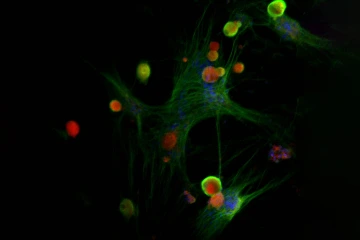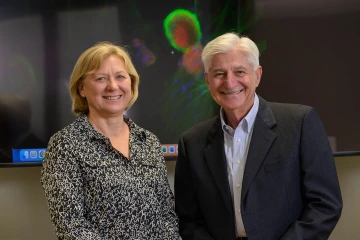Researchers hope to help women with endometriosis pain
Comprehensive Center for Pain and Addiction researchers are examining the link between prolactin and endometriosis, a painful condition that affects women.

Researchers are examining the role of a hormone called prolactin in the pain of endometriosis and how endometriosis might predispose women to other pain conditions.
Millions of women in the United States have endometriosis, a medical condition that in some women may cause infertility and severe pelvic pain, especially during menstrual periods.
A woman’s uterus is lined with the endometrium, a mucous layer that supports the implantation of the embryo. Without implantation of a fertilized egg, the endometrial lining is shed during the menstrual cycle. Endometriosis occurs when endometrial-like tissue grows outside of the uterus in other areas, including the fallopian tubes, ovaries, peritoneal wall, stomach or intestines. These tissues form cysts that can lead to inflammation and scarring.

Edita Navritalova, PhD, focuses her research on pain, including the neuropharmacology of pain and mechanisms of acute and chronic pain.
The underlying cause of endometriosis is unknown, but one of the prevailing theories has to do with the immune system.
“Normally, the immune system removes any endometrial tissue that doesn’t belong in this area, but for some women the immune response is inadequate, and the tissue grows,” said Edita Navratilova, PhD, member of the University of Arizona Health Sciences Comprehensive Center for Pain and Addiction and associate professor of pharmacology at the UArizona College of Medicine – Tucson.
More research is needed to find the cause of and a cure for endometriosis. At the same time, there is a critical need to develop better ways of managing the pain associated with the condition.
“Treatments for endometriosis usually rely on pain medications, surgery or hormonal therapies, such as those used for birth control,” said Frank Porreca, PhD, associate department head and professor in the Department of Pharmacology at the College of Medicine – Tucson and Comprehensive Center for Pain and Addiction member. “Surgery can clear the lesions, but the endometriosis and pain often comes back. Birth control can be effective, but that is not helpful for women who might be trying to conceive. We have found a hormone that might play a direct role in the pain of endometriosis and targeting it would not interfere with family planning.”
Navratilova and Porreca are examining the role that the hormone prolactin plays in endometriosis-related pain, as well as how endometriosis might unexpectedly predispose women to comorbidities including migraine pain.
How prolactin contributes to pain

A microscopic image shows the interaction of prolactin receptors (green) with human female sensory neurons, or nerve cells (red). Research has shown that females have more prolactin receptors than males, which Navratilova says could explain why women are more sensitive to painful stimuli than men.
Prolactin is a hormone with hundreds of physiological functions. Found at higher levels in females than in males, it is best known for assisting mammary gland development and stimulating milk production.
Previous research by Navratilova and Porreca found that the interaction of prolactin with pain receptors may explain why some pain conditions, such as migraine, fibromyalgia and pelvic pain, are more common in women.
“Our research showed that prolactin changes the threshold for activation of pain receptors called nociceptors,” Porreca said. “Higher prolactin levels in female animal models lowered the threshold for triggering migraine pain, but interestingly, higher prolactin levels had no effect on males.”
“The answer to why women have more pain may be because female nociceptors have more receptors for prolactin and with high prolactin levels become more sensitive to painful stimuli,” Navratilova added.
Targeting prolactin to treat endometriosis pain
If prolactin has such a strong correlation with female-predominant pain conditions, then it stands to reason that female-specific conditions, such as endometriosis, could have a similar or even stronger relationship.

Frank Porreca, PhD, studies the mechanisms of chronic pain states and opioid-induced hyperalgesia.
“Our previous research linking prolactin to several different conditions in several areas of the body suggest that there is a higher level of prolactin in the whole system,” Porreca said. “But endometriosis lesions have also been shown to produce prolactin locally.”
In the systematic review “Prolactin and pain of endometriosis,” Navratilova and Porreca examined 18 peer-reviewed, published papers that focused on the relationship between prolactin levels and endometriosis. The research studies included comparisons of patients with varying severities of endometriosis, as well as fertility and infertility issues among those with and without endometriosis.
All but one of the studies found that prolactin levels are higher in women with endometriosis.
“This review gives us a clinical rationale for studying prolactin as a potential mechanism that promotes pain in the disease,” Navratilova said. “The goal is to eventually develop drugs that can lower prolactin levels or target prolactin receptors as a means of treating endometriosis pain.”
Navratilova says some dopamine agonists, drugs that activate dopamine receptors in the brain and have similar effects as the neurotransmitter dopamine, have been shown to lower blood levels of prolactin and help alleviate migraines. Specific dopamine agonists are already being used to treat neurological disorders, such as Parkinson’s disease.
“We think these drugs might also help patients with the pain of endometriosis,” she said. “And they could possibly help decrease or eliminate endometriotic lesions as well.”
A step toward more holistic care

Navratilova first started working with Porreca as a postdoctoral research associate in his lab. Now as colleagues, they collaborate on many research projects, including the role of prolactin in female predominant pain conditions and the connection between endometriosis and migraine.
Navratilova and Porreca, along with postdoctoral research associate Grace Lee, PhD, are currently investigating the comorbidity of endometriosis and migraine, or the prevalence of the two different conditions appearing together in the same patient. Their early research in animal models shows that higher prolactin levels and stress appear to be common denominators when both conditions are present.
They say recognizing that these conditions may have an overlapping mechanism is a step toward more holistic care.
“If you think about how our medical system works, when a woman has migraine, she goes to a neurologist. The neurologist may not ask about pelvic pain. When she has pelvic pain, she might go to a gynecologist. That individual may not ask about migraine,” Porreca said. “But these conditions are overlapping in the same woman and stressful, and stress increases prolactin, which can feed into other pain conditions. So, addressing prolactin could be a way of treating the whole person.”
Our Experts
Edita Navratilova, PhD
Associate Professor, Department of Pharmacology, College of Medicine – Tucson
Member, Comprehensive Center for Pain and Addiction
Frank Porreca, PhD
Associate Head and Professor, Department of Pharmacology, College of Medicine – Tucson
Professor, Department of Anesthesiology, College of Medicine – Tucson
Member, Cancer Biology Program, UArizona Cancer Center
Contact
Brian Brennan
UArizona Health Sciences
520-621-3510
brianbrennan@arizona.edu

